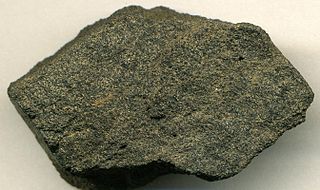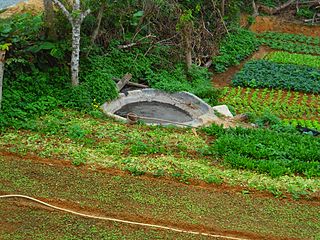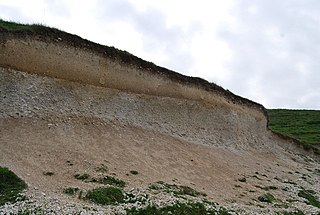
Limestone is a common type of carbonate sedimentary rock which is the main source of the material lime. It is composed mostly of the minerals calcite and aragonite, which are different crystal forms of calcium carbonate. Limestone forms when these minerals precipitate out of water containing dissolved calcium. This can take place through both biological and nonbiological processes, though biological processes, such as the accumulation of corals and shells in the sea, have likely been more important for the last 540 million years. Limestone often contains fossils, and these provide scientists with information on ancient environments and on the evolution of life.

Marl is an earthy material rich in carbonate minerals, clays, and silt. When hardened into rock, this becomes marlstone. It is formed in marine or freshwater environments, often through the activities of algae.

Soil pH is a measure of the acidity or basicity (alkalinity) of a soil. Soil pH is a key characteristic that can be used to make informative analysis both qualitative and quantitatively regarding soil characteristics. pH is defined as the negative logarithm (base 10) of the activity of hydronium ions in a solution. In soils, it is measured in a slurry of soil mixed with water, and normally falls between 3 and 10, with 7 being neutral. Acid soils have a pH below 7 and alkaline soils have a pH above 7. Ultra-acidic soils and very strongly alkaline soils are rare.

Plant nutrition is the study of the chemical elements and compounds necessary for plant growth and reproduction, plant metabolism and their external supply. In its absence the plant is unable to complete a normal life cycle, or that the element is part of some essential plant constituent or metabolite. This is in accordance with Justus von Liebig’s law of the minimum. The total essential plant nutrients include seventeen different elements: carbon, oxygen and hydrogen which are absorbed from the air, whereas other nutrients including nitrogen are typically obtained from the soil.

Rock flour, or glacial flour, consists of fine-grained, silt-sized particles of rock, generated by mechanical grinding of bedrock by glacial erosion or by artificial grinding to a similar size. Because the material is very small, it becomes suspended in meltwater making the water appear cloudy, which is sometimes known as glacial milk.

Liming is the application of calcium- (Ca) and magnesium (Mg)-rich materials in various forms, including marl, chalk, limestone, burnt lime or hydrated lime. In acid soils, these materials react as a base and neutralize soil acidity. This often improves plant growth and increases the activity of soil bacteria, but oversupply may result in harm to plant life.

Phosphorite, phosphate rock or rock phosphate is a non-detrital sedimentary rock that contains high amounts of phosphate minerals. The phosphate content of phosphorite (or grade of phosphate rock) varies greatly, from 4% to 20% phosphorus pentoxide (P2O5). Marketed phosphate rock is enriched ("beneficiated") to at least 28%, often more than 30% P2O5. This occurs through washing, screening, de-liming, magnetic separation or flotation. By comparison, the average phosphorus content of sedimentary rocks is less than 0.2%. The phosphate is present as fluorapatite Ca5(PO4)3F typically in cryptocrystalline masses (grain sizes < 1 μm) referred to as collophane-sedimentary apatite deposits of uncertain origin. It is also present as hydroxyapatite Ca5(PO4)3OH or Ca10(PO4)6(OH)2, which is often dissolved from vertebrate bones and teeth, whereas fluorapatite can originate from hydrothermal veins. Other sources also include chemically dissolved phosphate minerals from igneous and metamorphic rocks. Phosphorite deposits often occur in extensive layers, which cumulatively cover tens of thousands of square kilometres of the Earth's crust.

Lime is a calcium-containing inorganic material composed primarily of oxides and hydroxide, usually calcium oxide and/or calcium hydroxide. It is also the name for calcium oxide which occurs as a product of coal-seam fires and in altered limestone xenoliths in volcanic ejecta. The International Mineralogical Association recognizes lime as a mineral with the chemical formula of CaO. The word lime originates with its earliest use as building mortar and has the sense of sticking or adhering.
A soil conditioner is a product which is added to soil to improve the soil’s physical qualities, usually its fertility and sometimes its mechanics. In general usage, the term "soil conditioner" is often thought of as a subset of the category soil amendments, which more often is understood to include a wide range of fertilizers and non-organic materials.

Organic fertilizers are fertilizers that are naturally produced. Fertilizers are materials that can be added to soil or plants, in order to provide nutrients and sustain growth. Typical organic fertilizers include all animal waste including meat processing waste, manure, slurry, and guano; plus plant based fertilizers such as compost; and biosolids. Inorganic "organic fertilizers" include minerals and ash. The organic-ness refers to the Principles of Organic Agriculture, which determines whether a fertilizer can be used for commercial organic agriculture, not whether the fertilizer consists of organic compounds.
Bone meal is a mixture of finely and coarsely ground animal bones and slaughter-house waste products. It is used as a dietary supplement to supply calcium (Ca) and phosphorus (P) to monogastric livestock in the form of hydroxiapathite. As a slow-release organic fertilizer, it supplies Phosphorus, Calcium, and a small amount of Nitrogen to plants.

Calcareous is an adjective meaning "mostly or partly composed of calcium carbonate", in other words, containing lime or being chalky. The term is used in a wide variety of scientific disciplines.
Agrogeology is the study of the origins of minerals known as agrominerals and their applications. These minerals are of importance to farming and horticulture, especially with regard to soil fertility and fertilizer components. These minerals are usually essential plant nutrients. Agrogeology can also be defined as the application of geology to problems in agriculture, particularly in reference to soil productivity and health. This field is a combination of a few different fields, including geology, soil science, agronomy, and chemistry. The overall objective is to advance agricultural production by using geological resources to improve chemical and physical aspects of soil.
Soil acidification is the buildup of hydrogen cations, which reduces the soil pH. Chemically, this happens when a proton donor gets added to the soil. The donor can be an acid, such as nitric acid, sulfuric acid, or carbonic acid. It can also be a compound such as aluminium sulfate, which reacts in the soil to release protons. Acidification also occurs when base cations such as calcium, magnesium, potassium and sodium are leached from the soil.
Soil biodiversity refers to the relationship of soil to biodiversity and to aspects of the soil that can be managed in relation to biodiversity. Soil biodiversity relates to some catchment management considerations.

Crushed stone or angular rock is a form of construction aggregate, typically produced by mining a suitable rock deposit and breaking the removed rock down to the desired size using crushers. It is distinct from naturally occurring gravel, which is produced by natural processes of weathering and erosion and typically has a more rounded shape.

The Michigan Limestone and Chemical Company operates the world's largest limestone quarry, which is located near Rogers City, Michigan. It was formed and organized in 1910; however, production did not begin until 1912. Ownership of the quarry has changed a number of times, but it is still one of the country's largest producers of limestone.

William Albert Albrecht chairman of the Department of Soils at the University of Missouri, was the foremost authority on the relation of soil fertility to human health and earned four degrees from the University of Illinois at Urbana–Champaign. As emeritus professor of soils at the University of Missouri, he saw a direct link between soil quality, food quality and human health. He drew direct connections between poor quality forage crops, and ill health in livestock and from this developed a formula for ideal ratios of cations in the soil, the Base Cation Saturation Ratio. While he did not discover cation exchange in the soil as is sometimes supposed, he may have been the first to associate it with colloidal clay particles. He served as 1939 President of the Soil Science Society of America.
Twenty years before the phrase 'environmental concern' crept into the national consciousness, he was lecturing from coast to coast on the broad topic of agricultural ecology.
" The soil is the ‘creative material’ of most of the basic needs of life. Creation starts with a handful of dust.” Dr. William A. Abrecht.

The calcium cycle is a transfer of calcium between dissolved and solid phases. There is a continuous supply of calcium ions into waterways from rocks, organisms, and soils. Calcium ions are consumed and removed from aqueous environments as they react to form insoluble structures such as calcium carbonate and calcium silicate, which can deposit to form sediments or the exoskeletons of organisms. Calcium ions can also be utilized biologically, as calcium is essential to biological functions such as the production of bones and teeth or cellular function. The calcium cycle is a common thread between terrestrial, marine, geological, and biological processes. Calcium moves through these different media as it cycles throughout the Earth. The marine calcium cycle is affected by changing atmospheric carbon dioxide due to ocean acidification.














